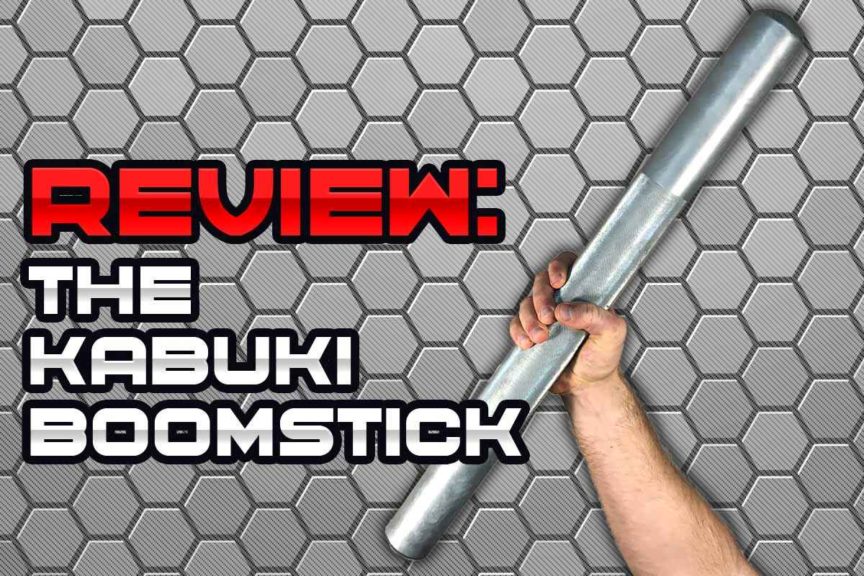Most active individuals would have no problems with getting professional soft tissue treatment on a regular basis if money simply weren’t an issue. But for a lot of us, it is. So we look for all sorts of ways to effectively treat our tight and fascially bound-up muscles on our own. You know, those poor things that endure the chronic punishment of heavy lifting and regular physical activity.
The bottom line: The Kabuki Boomstick is a very unique and valuable IASTM tool that can be of great use to specific populations, particularly lifters and certain athletes. The Boomstick is a solid investment for those who are looking for ways to self-target deeper muscles and fascial restrictions that are otherwise hard to get at by themselves using other tools.
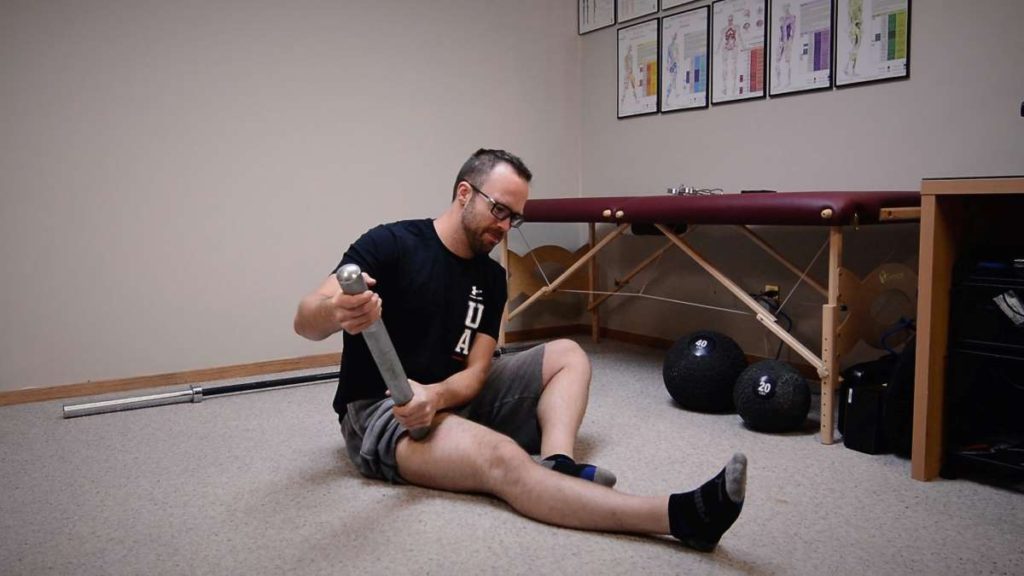
If you want to learn more of the specifics and my subsequent thoughts around this little nineteen-pound beast, then keep on reading!
Article contents (Quick links)
Click/tap on any of the bulleted headlines below to instantly jump to that particular section of the article.
- My introduction to the Boomstick
- What makes the Boomstick so unique?
- Who is the Boomstick best suited for?
- Strengths of the Boomstick
- Limitations of the Boomstick
- Price to performance ratio
- Final thoughts
Related articles:
- IASTM: Here’s How it Works to Decrease Pain and Improve Mobility
- Why You Shouldn’t Spend TONS of Money on IASTM Tools
My introduction to the Boomstick
A few years ago I was at a fellow healthcare practitioners residence, picking their brain on all sorts of great knowledge they had that I myself wanted. (I pick the minds of brilliant movement-based therapists a lot.) As we hung out and discussed various topics, I noticed a unique looking metal bar laying on the floor by their collection of kettlebells and other training equipment. Not sure what it was, I asked.
Turns out that I was staring at the Kabuki Boomstick. Not having seen or heard of it before, I began asking more questions about it to the fellow practitioner who owned it. Before I knew it, I was trying it out on myself for both my upper and lower body. Not too many minutes after, I realized that I wanted one for myself. As I continued to use it, I quickly realized that this was something that would allow me to much more aggressively treat the soft tissues in my legs than any other device that I owned.
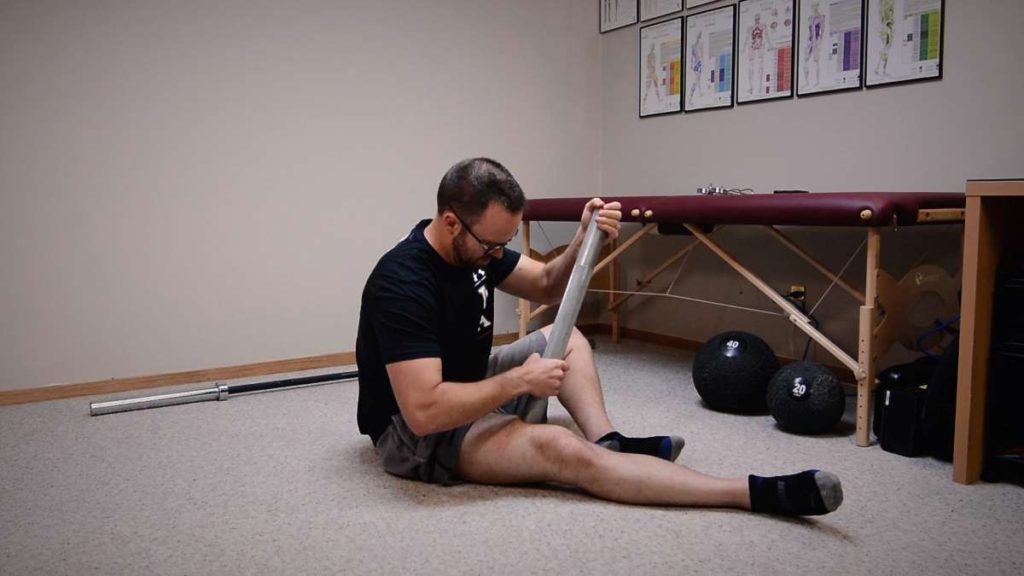
The ability to effortlessly and rather precisely target parts of my body containing deeper tissues that were otherwise hard to get at on my own was an amazing feeling; it’s pretty hard to get these deeper muscles with smaller IASTM tools or be as precise when rolling even on aggressive foam rollers (I roll on a PVC pipe).
Now, after having owned and used my Boomstick for a few years, the time has come to offer my thoughts as to whether or not this piece of steel is right for you.
What makes the Boomstick so unique?
Kabuki Strength is the company behind the Boomstick. Kabuki makes some seriously great lifting gear and products for those who are serious about their lifting, getting stronger and moving better. I don’t have any affiliations with them, so I’m not just trying to push any sales on you here – I just really believe they make some awesome stuff.
What makes the Boomstick such a unique piece of equipment is the fact that it is a heavy, dense piece of iron that allows an individual to target deeper musculature more effectively and aggressively than with more traditional self-myofascial treatment approaches. And for what it’s worth, it’s actually the smaller, more nimble brother of its big brother, the 44-pound Pain Pill.
The uniqueness of the Boomstick stands out in a few ways:
First, the Boomstick allows you to more effectively target and treat deeper musculature (and to a much more aggressive extent, if need be) than with more traditional self-myofascial treatment approaches. Traditional, hand-sized IASTM tools are great for a lot of applications, but they’re just not meant for getting to deeper and thicker structures. And traditional means of interventions like foam rolling your legs doesn’t offer much focal precision for deeper yet specific areas that need work.
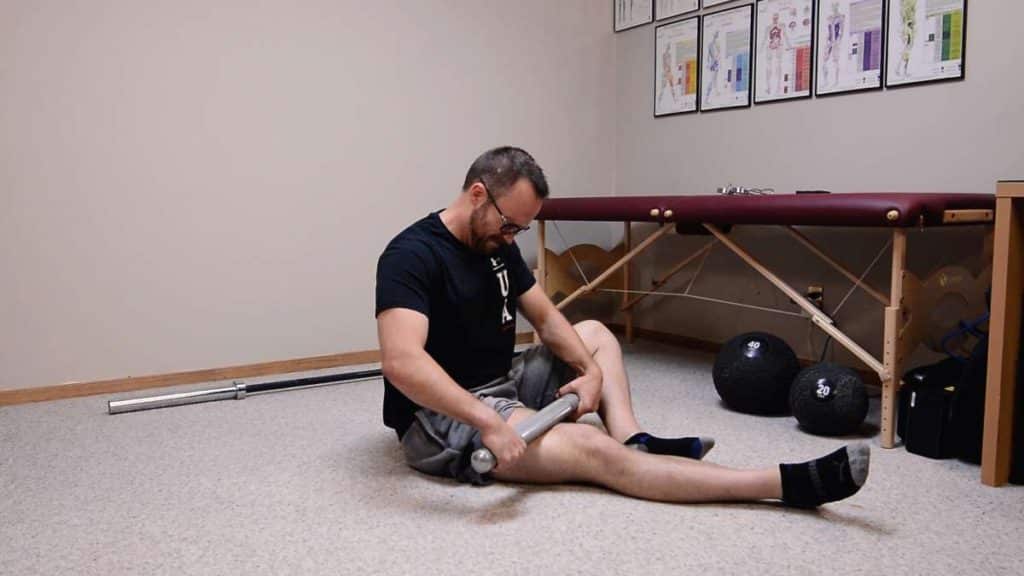
Second, the Boomstick affords a much easier and less energy-intensive way to target and treat the deeper muscles and tissues in your body than when attempting to do a more traditional intervention such as foam rolling on your lower body. Ever try to spend twenty minutes treating a single leg while supporting yourself on a foam roller? Your shoulders and elbows get exhausted often before your legs get the treatment time they need.
Now, just so we’re clear, I don’t mind using foam rolling for some transient tissue changes right before a lift or movement session, but I haven’t found any evidence in the literature to suggest that it creates lasting change (I mean, once you cut open a cadaver and seeand feel how thick some fascial structures are in our body, you lose faith in soft foam rollers rather quickly). If lasting change is going to come to those tissues, I’d wager it will come from more aggressive and focal treatments using something to the likes of the Boomstick.
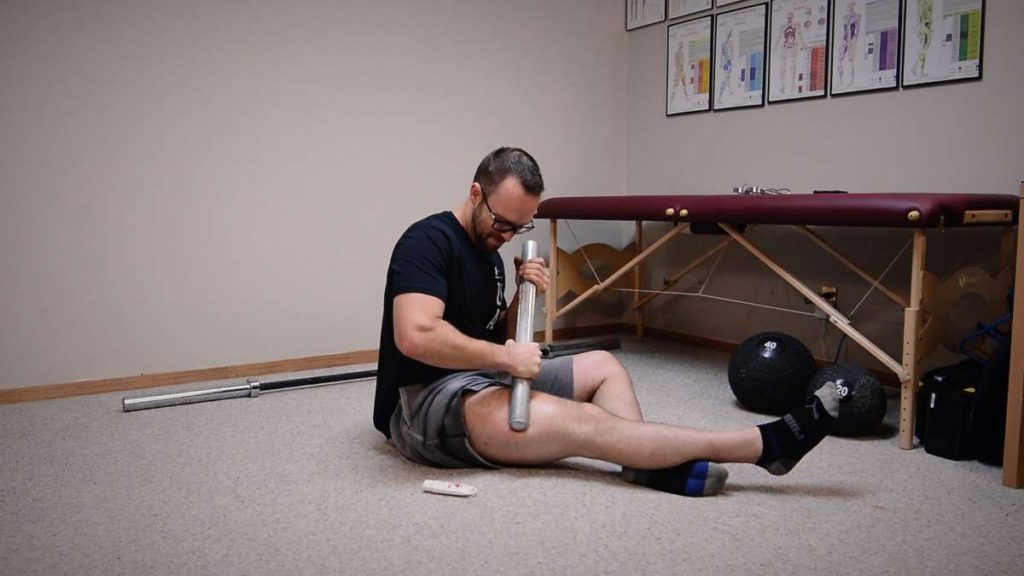
Use on yourself or certain patients if you’re a healthcare practitioner
While I would say that most people wind up using the Boomstick on themselves, it can also come in handy for practitioners who are treating certain patients.
While it may seem a bit unconventional to some to have someone like me (a physical therapist) use a Boomstick on a patient, there are a handful of times where it comes in handy for me, particularly when I’m dealing with 250+ pound powerlifters and strength athletes who push their bodies to the extremes and have deep muscles that are facially bound up and stiff as braided steel cable. As a clinician, I will tell you that every tool and treatment intervention has a time and a place.
Sure, I’ll use intramuscular needling on them and all sorts of other techniques, but the butt-end of a Boomstick will do a better job on certain areas of their bodies than my elbows or my hands ever could while saving tons of energy for my next patients in the day. That and, you know, I’d like to not give my hands raging osteoarthritis by the time I’m in my early forties; manual therapists are rather prone to developing early OA in their hands due to their daily job requirements.
Who is the Boomstick best suited for?
The quick takeaway: While in the grand scheme of things the vast majority of the general population could in fact benefit from using the Boomstick, it’s ultimately best suited for individuals who push themselves physically in their lifting pursuits and aren’t afraid to push themselves just as much when it comes to keeping their soft tissues healthy.It’s also a wise choice for those who can’t afford to get regular soft-tissue treatments from qualified healthcare professionals.
Is the Boomstick necessary for a lifter’s or athlete’s survival? No. Does it easily allow self-treatment that targets and treats deep and superficial structures that often need some manual manipulation? You bet. Can this lead to better lifts, decrease pain and improve a lifter’s performance and longevity? Absolutely.
Related: IASTM: Here’s How it Works to Decrease Pain and Improve Mobility
With that said, let’s look specifically at the two demographics who I personally feel can really benefit from this little beast:
Folks who train hard
Training hard and taking it seriously is awesome, but if you want to maximize your training longevity (and overall movement health), you really need to take your recovery and tissue health just as seriously. If you’re someone who has the money to regularly get high-quality soft tissue treatment from a qualified professional, that’s certainly the thing to do (if not, see the next section).
But even if you do have the financial means, it’s nice to be able to effectively treat yourself at home when you don’t have the time or ability to drive across town for treatments. Doing things effectively at home can feel quite nice from a time and energy saving standpoint.
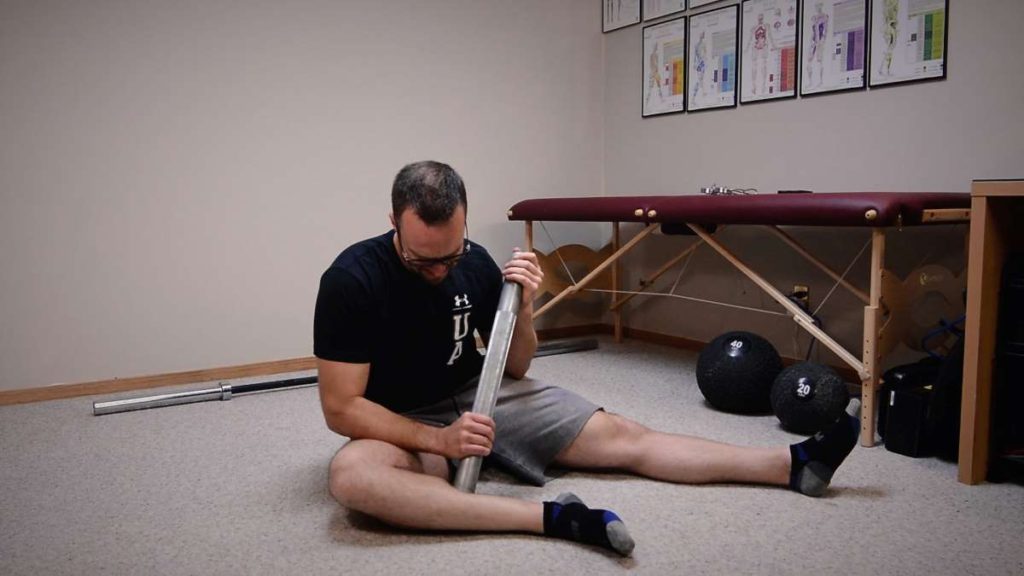
Folks who don’t have the finances for regular soft tissue treatments
Getting regular soft tissue treatment from qualified health professionals is always a smart move, but many of us lifters and athletes just don’t have the finances to make this happen on a regular and frequent basis. No doubt this was me as I continued to train regularly throughout my undergraduate and graduate studies. Any available money I had went to “frivolous” things such as food and rent.
Related: Why You Shouldn’t Spend TONS of Money on IASTM Tools
This is where the Boomstick absolutely shines. While it was a big purchase for me at the time (a broke, in-debt grad student), I knew that it could help with a lifetime of self-treatments that would otherwise cost about as much as two soft-tissue treatments from a qualified massage therapist or other practitioner.
Getting treatments from others is great because they can often not only dig into deeper tissues better than we can on our own, they can often do it with more precision on certain areas. The beauty of the Boomstick is that you can do this on your own to a very effective extent based on how you hold it and use it.
While nothing will replace the effectiveness of having an experienced and qualified professional perform soft tissue release on you, the Boomstick is about the next best thing if you’re looking for something that can be both aggressive and precise.
Strengths of the Boomstick
Well, for one thing, you don’t have to worry about durability issues since it’s just a solid piece of steel, that’s for sure. This thing no doubt will have a lifespan longer than yours and mine combined.
On a more application-based note, the Boomstick does have some unique strengths that are hard to come across through any other mobility-based piece of equipment. Sure, you could use the end of a barbell to also smash and roll the tissues in your leg, but even in doing that you’re a bit more limited than what can be done with the Boomstick. Let me explain.
The beauty of the Boomstick is that it’s small enough that it doesn’t take up any real space, even in a small apartment, and you could transport it around without any real issue if you really wanted (just lugging around the weight of it may be a hassle).
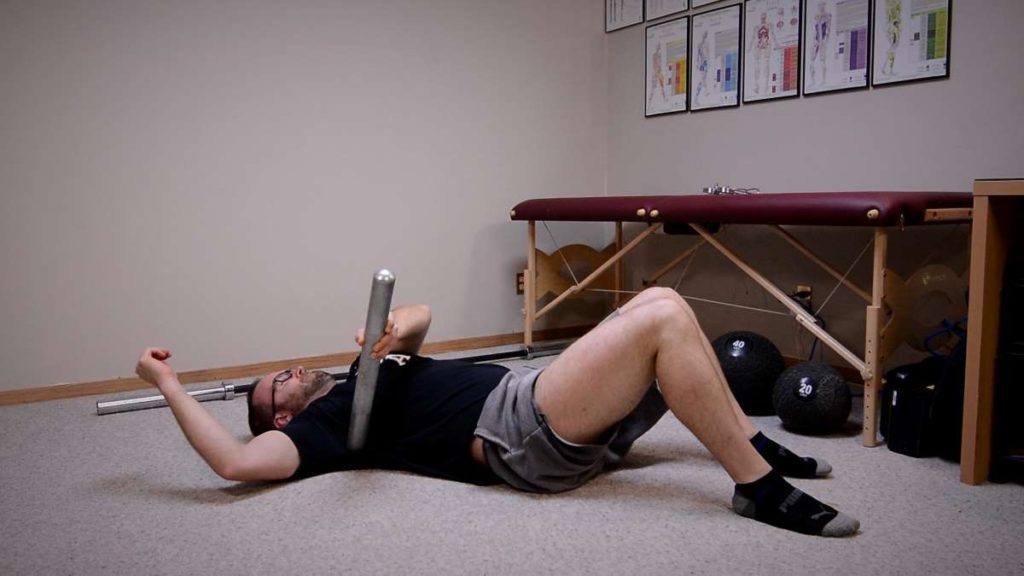
I’m all for smashing and rolling tissues with the end of a barbell, but that’s a hard thing to do if you can’t exactly fit a barbell in your apartment, or easily put it in your car, which means that it actually has a unique strength of being easily portable, if needed. However, since it’s hefty enough that you likely won’t bring it to the gym for every session, it’s heft can also be seen as a bit of a limitation, which I’ll discuss a bit later.
Limitations of the Boomstick
Like pretty much anything else in existence, there are some limitations that the Boomstick has. I wouldn’t go so far as to call the “drawbacks” or “weaknesses” but rather “limitations” since no single product can do absolutely everything. It’s important to know what the limitations are for anything that one buys, as no one wants to spend their money one something that they later find out they were misinformed on.
Portability
While the Boomstick is certainly small enough to be lugged around without taking up any major space, it’s not exactly something that you’ll just casually throw in your gym bag and bring to the gym (it is a bit too long for most gym bags and won’t be fun to carry…believe me, I’ve tried). It’s best left in an area that you’ll be able to frequently use it without needing to constantly bring it along with you.
Again, this isn’t a “drawback” per se, as the Boomstick was never designed to be a highly portable IASTM device. So don’t plan on bringing it to the gym every day, but do realize that it’s incredibly easy to move it from one room to another or throw it in your trunk or back seat.
Price to performance ratio
I’ve got absolutely no issues with the price of purchasing a Boomstick; the cost of the raw material needed to manufacture and refine the product are where most of your money goes when purchasing this tool.
Add on the fact that the cost of purchasing a Boomstick (essentially resulting in unlimited future self-treatments) is about the same as a couple or few soft tissue treatments from a qualified professional and the cost becomes incredibly justifiable.
Related: Why You Shouldn’t Spend TONS of Money on IASTM Tools
You will likely have to pay for some moderately hefty shipping fees, but you can’t pin that on the folks a Kabuki. However, what’s super awesome is that Kabuki often has Black Friday deals that allow for free shipping once a year. This is when I picked mine up, as I needed a bit of time to save up for it anyways, being a broke grad student and all. So if you’re in no major hurry, you may want to look into purchasing one then.
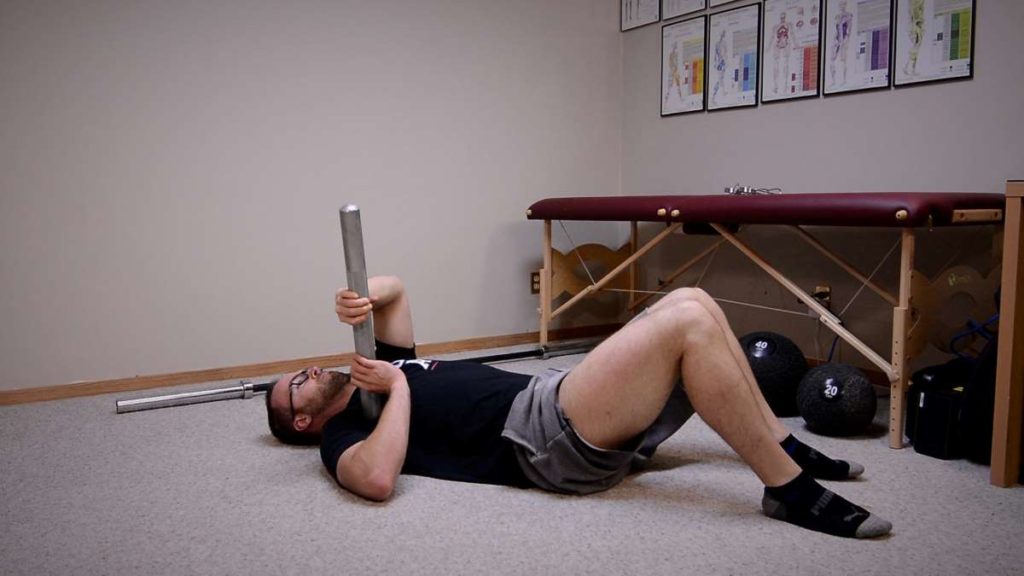
Another great option is to pick up one of their “blemished” models; sometimes during the manufacturing process the Boomstick will end up with some cosmetic blemishes, which then are price-reduced by the folks at Kabuki. If you’re not concerned about cosmetic defects then it might be worth grabbing one of those.
After all, it’s just a piece of mechanically-refined steel that you’ll be using on your body; it’s not a sports car you’ll be constantly driving around and showing to your friends and the general public.
Final thoughts
The Boomstick is certainly worthy of being added to your arsenal of tools that help keep you moving well and keep your lifting game strong. It’s pretty easy to justify the expense when you consider the amount of money it can save you in the long run for seeking additional treatments from someone else. Add to the fact that it will last forever, it’s incredibly versatile and does what few other soft-tissue self-treatment methods let you do on your own and it’s pretty much a no-brainer.
At the end of the day, it’s your money and your body and only you know what’s best for both of those based on your own personal circumstances. But if you’re looking for something that can give you some solid soft-tissue treatment, this is one IASTM tool that I could certainly add to my arsenal.
Move well. Live bold.
-Jim

Hi! I’m Jim Wittstrom, PT, DPT, CSCS, Pn1.
I am a physical therapist who is passionate about all things pertaining to strength & conditioning, human movement, injury prevention and rehabilitation. I created StrengthResurgence.com in order to help others become stronger and healthier. I also love helping aspiring students and therapists fulfill their dreams of becoming successful in school and within their clinical PT practice. Thanks for checking out my site!

